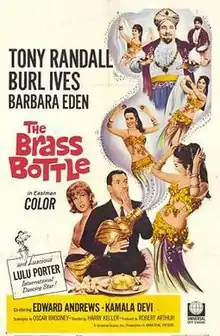The Brass Bottle (1964 film)
The Brass Bottle is a 1964 American fantasy-comedy film about a modern man who accidentally acquires the friendship of a long-out-of-circulation genie. It is based on the 1900 novel of the same title by Thomas Anstey Guthrie and later inspired the American fantasy sitcom I Dream of Jeannie.
| The Brass Bottle | |
|---|---|
 Theatrical release poster | |
| Directed by | Harry Keller |
| Produced by | Robert Arthur |
| Written by | Oscar Brodney |
| Based on | The Brass Bottle by Thomas Anstey Guthrie |
| Starring | Tony Randall Burl Ives Barbara Eden |
| Music by | Bernard Green |
| Cinematography | Clifford Stine |
| Edited by | Milton Carruth Ted J. Kent |
| Distributed by | Universal Pictures |
Release date |
|
Running time | 87 minutes |
| Country | United States |
| Language | English |
The film stars Tony Randall, Burl Ives and Barbara Eden.
Plot
Architect Harold Ventimore (Tony Randall) buys a large antique container that turns out to imprison a genie named Fakrash (Burl Ives), whom Harold inadvertently sets free. Fakrash is effusively grateful for his release, and persistently tries to do favors for Harold to show his gratitude. However he has been in the brass bottle for a long time, and Fakrash's unfamiliarity with the modern world causes all sorts of problems when he tries to please his rescuer. Harold ends up in a great deal of trouble, including with his girlfriend, Sylvia Kenton (Barbara Eden).
Cast
- Tony Randall as Harold Ventimore
- Burl Ives as Fakrash
- Barbara Eden as Sylvia Kenton
- Kamala Devi as Tezra, a female genie
- Edward Andrews as Professor Kenton
- Lulu Porter as a belly dancer
- Richard Erdman as Seymour Jenks
- Kathie Browne as Hazel Jenks
- Ann Doran as Martha Kenton
- Philip Ober as William Beevor
- Parley Baer as Samuel Wackerbath
- Howard Smith as Senator Grindle
Production
Background
Thomas Anstey Guthrie's novel, on which the film is based, had been adapted for the screen twice before during the era of silent film in 1914 and 1923.
Casting
At this point in his career, Tony Randall was one of Hollywood's leading supporting players, and this film represented a "rare opportunity" for him to get first billing.[1]
Filming
The Brass Bottle was made on a modest budget and shot primarily on the back lot of Universal Studios, with a few exterior sequences made with rear screen projection, "giving the feature film the look of a standard sitcom from the era."[1]
Release and reception
The Brass Bottle was released on May 20, 1964.
Home media
The Brass Bottle was released on DVD for Region 1 (U.S. and Canada only) as part of the Universal Vault Series in January 2010.[2]
Contemporary
The New York Times critic A. H. Weiler found the film "about as funny as your own funeral", and dismissed it as "one of the duller fantasies dreamed up by Hollywood's necromancers."[3]
Retrospective
Tony Mastroianni says The Brass Bottle is 'not a bad little movie" for what it is: "well-made but rather unpretentious."[4] Lee Pfeiffer notes the "inspired cast" and finds the film "mildly amusing" Overall, he says the film "clearly belongs" to Burl Ives, who is "genuinely amusing" as a genie trying to learn how to live in the 20th century and "dominates every scene he is in".[1] Craig Butler calls The Brass Bottle a "silly and fairly predictable comedy, the kind that Hollywood was making in the early 1960s before it figured out that people were more and more getting this kind of fluff on television, where it was more at home." While not a great comedy, it is "pleasant, amiable and diverting".[5]
Legacy
Eden's role was instrumental in getting her cast as the star of the TV series I Dream of Jeannie, even though she did not play a genie in this film.[6]
Remakes
This film was remade in Tamil by Javar Sitaraman as Pattanathil Bhootham (or Ghost in the City) in 1967, and was a critical and commercial success.
References
- Pfeiffer, Lee. "DVD review: "The Brass Bottle" (1964) starring Tony Randall, Burl Ives and Barbara Eden". CinemaRetro.com. Retrieved 31 May 2020.
- "The Brass Bottle (1964)". Retrieved 2012-11-24.
- A. H. Weiler (May 21, 1964). "Tony Randall Stars in 'The Brass Bottle'". The New York Times.
- Mastroianni, Tony (November 20, 2003). "[Review, The Brass Bottle]". Cleveland News.
- Butler, Craig. "The Brass Bottle (1964)". AllMovie. Retrieved 31 May 2020.
- Hooch.net I Dream of Jeannie: Then, Now, and Fun Facts About the Show: "The TV Show Was Inspired By A Movie" retrieved August 15, 2019